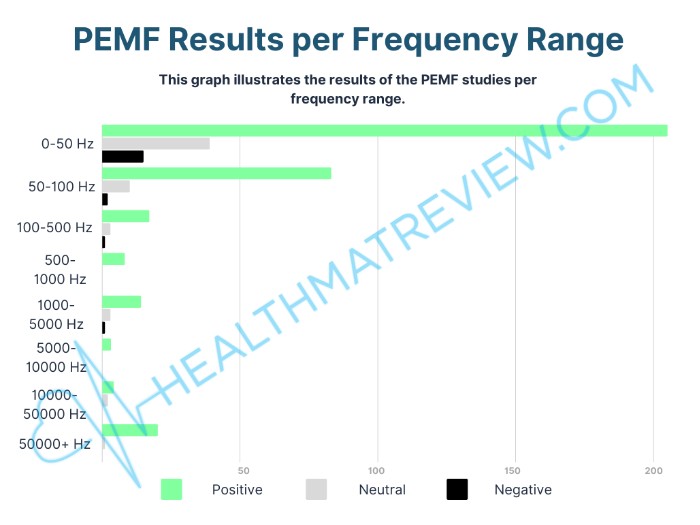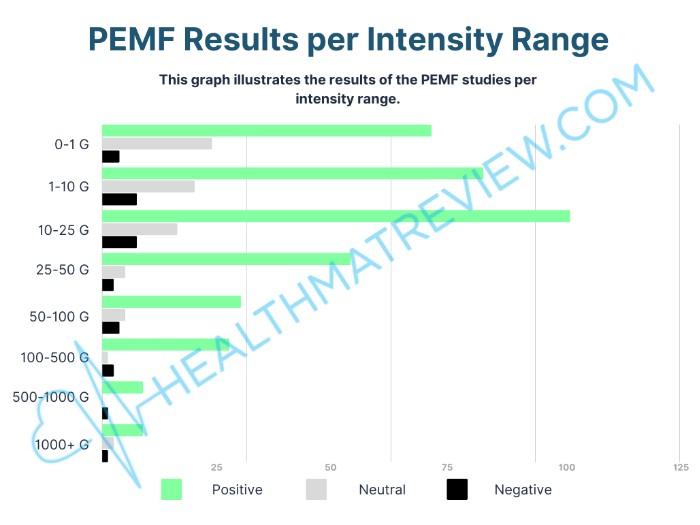PEMF therapy does work and we say this because the majority of PEMF studies from our database, just over 80%, found positive results.
This statement is based upon the results which were found in the database we built of 335 PEMF research studies, and the chart below depicting these results.
Disclaimer: it is the nature of what a PEMF study is investigating which determines the result to be positive, negative, or neutral, and no study found PEMF to cure any disease.
The process,
Disclaimer: the copyright of all referenced PEMF studies belong to the respective authors & their associates. Health Mat Review has assimilated a large number of these studies for a macro-analysis of their PEMF properties to give ourselves & our readers greater perspective of the current PEMF therapy knowledge base.
This article is based on our analysis of 335 PEMF research studies sourced from PubMed, which we compiled into a searchable PEMF research database.
We examined the results to understand whether PEMF works, what conditions it may help with, and which settings—like frequency and intensity—are most effective.
The infographic above highlights our process, for a deeper dive into the full analysis and more answered questions, visit our main PEMF therapy page.
Let’s get into it!
PEMF Study Results Chart

The chart above shows in each vertical bar how many studies from our database belong to each result category, Positive, Neutral, Negative, etc.
As can be seen in the first column, the majority of PEMF studies out of our database found positive results – over 80% – and this is what I based the answer at the top of this page on, that yes PEMF therapy does work.
As with any research study, results from some may have been inconclusive or requiring further experimentation. This is why some studies have been given a “Positive, Neutral” status, or “Positive, Negative” etc. as seen on the chart above.
Further to the disclaimer as noted above, the results of a study are dependent on the research objective.
For example, some studies may have been looking at whether or not exposure to ongoing pulsing electro-magnetic fields was harmful to individuals or to cell cultures in the lab. A positive result for this study would be only that no harm was done to the individuals or cell cultures, it would not necessarily mean that further benefits were observed.
Quoting a couple PEMF research studies…
The titles of these studies can get a little involved, but let’s look at a couple examples.
This study looked at the benefits of PEMF for chronic pain management:
Quoting the study,
- “PEMF may be a novel, safe and effective therapeutic tool for use in at least certain subsets of patients with chronic, nonmalignant pain.”
Another study looked at inflammation management:
And quoting this study,
- “PEMF is showing promise as a treatment for inflammatory regulation to be used to promote tissue regeneration.”
Many studies sound similar in their conclusions that some type of benefit over the baseline test group was found and typically they also say that more research is needed in the area to confirm results.
Check out the section I put together on the 10 most studied benefits of PEMF on our PEMF mat benefits page for more interesting research study quotes.
In my opinion after reading many of these research studies, it’s fairly clear to see that PEMF is still in the beginning stages of being understood.
That’s actually a factor in why I recommend certain PEMF mats over other ones, I think it’s wise to get one that has a lot of flexibility in the PEMF settings in case future research shows more benefits at one frequency or another, there will be a better chance you can just plug in that setting and go.
Now where did the 335 PEMF Studies in the database find results, at what Frequencies and Intensities?
Now for the interesting stuff, where did these PEMF studies find their positive, neutral, or negative results?
That is, at what intensities and frequencies were what kind of results found?
On the following two charts we show the number of studies finding positive, neutral, or negative results within each range band denoted along the left hand side of the charts.
Results per Frequency Range
The first thing you will probably notice is the longest green bar right across the top in the lowest frequency range, from 0 to 50 Hz, this range has more than 200 positive result studies.
Along the bottom axis is the number of studies indicated by the length of the bars, and in each frequency band the colors of the bars, green, gray and black show positive, neutral and negative results respectively.

Frequency is denoted in Hz, or Hertz, 1 Hz meaning once per second, 2 Hz being twice per second, and so on. Frequency range bands indicated along the left hand side, and number of studies noted along the bottom.
The chart clearly shows that,
- The largest number of positive results were found below 50 Hz
- Almost all positive results of the studies were found in the first two frequency bands, from 0 to 50 Hz and from 50 to 100 Hz
This is a strong indication for those looking to buy a PEMF device to find one with flexibility in the low frequency band, below 50 Hz.
Results per Intensity Range
In this chart we see the range of intensity bands tested has a more even distribution than the frequency bands.
As with the frequency chart, the number of studies is indicated along the bottom, with the colored bars indicating how many positive, neutral and negative result studies were found in each band.
You may notice that the first two intensity bands only represent a small range of up to 1 Gauss and then up to 10 Gauss, whereas, the third band represents a range of 15 Gauss, and the fourth a range of 25 Gauss.
This shows us that there were a large number of positive results in just the very small range of 1 Gauss and below on the first band, and another large number of positive results also at low intensity levels of up to only 10 Gauss in the next band.

Magnetic Field Intensity is denoted in Gauss with intensity range bands indicated along the left hand side.
Key points from the chart above are,
- Positive results are found across a wide range of PEMF intensities
- There isn’t any indication that a high intensity PEMF is more effective than low intensity
- The heaviest distribution of positive results are in the low intensity bands, almost all between 0 up to 25 Gauss
- For the narrowest range band of just 0 to 1 Gauss (only 1 Gauss wide, versus next narrowest band of 10 Gauss) it shows a disproportionate number of positive result studies
This indicates when choosing a PEMF device that it would be wise to find one which offers low intensity settings.
We will see on our page on PEMF safety that high intensity PEMF can be safe but only at absolute minimal frequency levels. It is the combined rate of frequency and intensity which determines total energy delivered and therefore whether a PEMF can be considered safe or not (at least in my own opinion).
With the effective PEMF frequency and intensity range bands in mind, I do have a best recommended PEMF product which is the Healthy Wave Multi-Wave Mat.
You can read the full detail review I wrote on it here:
What is PEMF Good for?
Because the mechanism of PEMF therapy is to improve cellular function in general it’s good for a great many different applications.
Some of the more notable ones are:
- temporary pain relief,
- circulation improvement, and
- improved sleep.
I actually wrote a whole page on the benefits of PEMF, based upon my own experience with my PEMF mat at home, and based upon the most studied topics in our PEMF research database which you can check out here:
If you found this interesting check these out next
You can find links to all our other pages on PEMF and what answers and results we got our of our 335 PEMF research study analysis on our PEMF therapy page, find out what the latest and best PEMF mats are on our best PEMF mats page or go search and filter through the studies of the analysis on the PEMF study explorer page.








Comments are moderated. Tick “Email me when my question is replied to” to get notified.